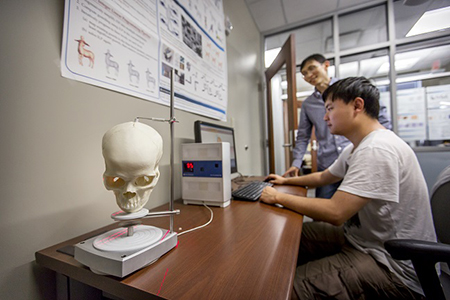Xin Li is Heads Above the Rest
LSU Professor to Speak at TEDxLSU
2-20-18
 Since 2013, Baton Rouge has hosted TEDxLSU, an intellectual and creative experience
that brings local, regional, and statewide communities together to discuss topics
and ideas that can propel Louisiana into the future.
Since 2013, Baton Rouge has hosted TEDxLSU, an intellectual and creative experience
that brings local, regional, and statewide communities together to discuss topics
and ideas that can propel Louisiana into the future.
Speakers at the event range from artists and teachers to business owners and scientists. This year, LSU Division of Electrical & Computer Engineering Associate Professor Xin “Shane” Li will discuss his work with computer graphics, artificial intelligence and skulls.
Yes, skulls.
As the head of LSU’s Geometric and Visual Computing Group, located in the Louisiana Digital Media Center, Li works with his team to develop computer programs that help people understand and analyze geometric or visual data such as images, videos, or 3D scans acquired from one’s daily life. In the past, his group has helped build an image-guided lung tumor motion-tracking system used to guide and optimize-next generation lung cancer radiotherapy treatment. The GVC Group has also worked with civil engineers to reconstruct flood hydrographs for Hurricane Harvey. But unlike both of those projects, Li’s current work may help lives already lost.
He is working with LSU Forensic Anthropology and Computer Enhancement Services (FACES) Laboratory Director Ginesse Listi, former FACES Lab Director Mary Manhein, LSU Associate Professor of Mechanical Engineering Warren Waggenspack and other FACES Lab forensic anthropologists to develop computer programs that can reconstruct a face from a fragmented skull to help with victim identification.
“I am pleased to say that this team has made substantial progress on automating a process that combines art with science for addressing a very personal and professional challenge,” Waggenspack said.
The current process of manual skull reconstruction takes days and sometimes weeks to complete. Thanks to the group’s expertise, the new digital reconstruction can be completed in mere hours.
“This procedure consists of three steps, from fragmented skull reassembly to damaged region restoration, to facial reconstruction and superimposition,” Li said. “Meanwhile, this research of developing novel reliable geometric processing and modeling techniques for data restoration and reconstruction from incomplete images or geometries has general and broader applications in many fields.”
“In cases of virtual or digital approximations, forensic artists can use photos to create a single composite image, but there are also software programs that allow them to ‘free hand’ an image without any photos at all,” Listi said. “Additionally, when forensic artists sculpt a 3D facial approximation using clay, photographs are not used at all.”
Though the digital system is not yet used by detectives in solving missing persons cases, Li and the FACES team aren’t far from making digital skull restoration a reality.
“We are still in the research phase,” Li said. “This is new, so we have to examine how accurate this could be. I’m very excited doing things like this, hoping this could actually bring some impact to our real life.”
"Shane's research is exciting in many ways,” Listi said. “We are hopeful that this research will allow us to create images that may generate new leads for resolving cases of unidentified persons, and thus, bring closure to families whose loved ones are missing."
TEDxLSU is Saturday, March 3 at 1:30 p.m. in the LSU Student Union Theater. Tickets must be purchased in advance by clicking here. All seating is general admission.
By Libby Haydel
Communications Specialist
ehaydel@lsu.edu
225-578-4840